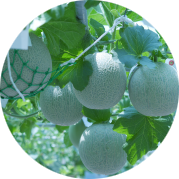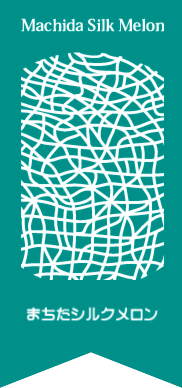INTRODUCTIONまちだシルクメロンとは
Made in Machida
In 2009, the Machida Chamber of Commerce and Industry linked up with a cooperative of 10 businesses from both inside and outside Machida to start hydroponic cultivation of the “Machida Silk Melon.” Faced with the lack of experienced fruit cultivators specializing in melons, Machida uses a cultivation method called the “Machida New Farming Method,”a system created from a variety of techniques. With the Machida Method, a melon plant that can generally only yield 1-4 melons can produce as many as 60. With a sugar content exceeding 15%, the Silk Melon‘s water-to-sugar ratio is that of a high-grade melon and is steadily being prepared for commercialization.


About the name
The elegant and appealing name “Machida Silk Melon” is a tribute to the Silk Road, a former silk trading route that included the Machida area from Hachioji to Yokohama Bay as a stopover. When ripe, the silk melon’s texture is silky-smooth and juicy”a high-quality product that truly lives up to its name.



The Path to Today’s Success
The current state of farming in Japan is endangered by economic globalization and faces issues of curtailment of farmland, the population of farmers aging and their lack of successors, the overabundance of imported food and deterioration of self sufficiency. The development of locally based agribusinesses (value-added agriculture) with the collaboration of agriculture, commerce, and industry is a constructive experiment to break down the present condition.

Features of the “yuragi” (fluctuation) cultivtion containzers
1.The number one feature of the Machida farming method is the use of hydroponic containers. After the liquid fertilizer flows from the center and collides with the inner walls of the containers, the containers are structured to drain from their four corners while accompanying convection.
2.Fluctuation, which helps the Karman vortex to promote convection and the absorption of nutrients from the roots, occurs in the containers.
3.Because the roots are raised to grow radially in an ideal direction and stagnation of the liquid is prevented, the health of the roots is preserved.
Method of Cultivation
Traditional Method of Cultivation

Because roots can flourish for drainage and drainage are located on the diagonal liquid f lows avoiding roots, nutrients reach the roots, roots or root rot in the stagnation of disease-prone.
The Machida Method of Cultivation

The vortex and f luctuation add to the radial f low from the center to the corners, creating an ideal environment for root growth.
Flow Chart of the Whole Apparatus

The Potential for Other Crops
Now that hydroponic cultivation is a possibility for growing melons, the unique techniques used in the “Machida New Farming Method”are garnering a lot of attention for use in the production of other crops. Currently, this ground-breaking method, which does not use pesticides, holds relatively little risk of illness, and may produce a higher yield, is being experimented with in the cultivation of tomatoes, cucumbers, and leafy greens.


